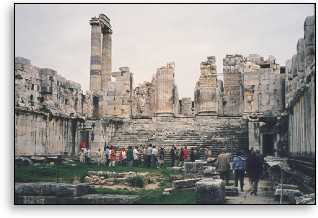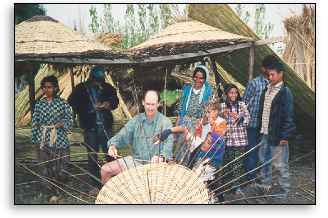Meander Valley,
Didyma,
Miletus,
Kusadasi
Western Turkey - Group Journal
Day 11 -
Tuesday, 14 April 1998
by Dennis, Christine, Clara Peck
0830 Temp 63 degrees F, altitude 940 ft, sunny and clear Good start after early morning cat serenade (in Turkish).
Health status report:
- still coughing (but improving): Geri Squires, Christine, Bud, Rakella, Jane, Martha, Dennis
- new cases: Pat
- kind of healthy: Jeri & Jim Jardine
- newly turned ankle: Cathy
- sprained ankle (improving) Becky
- knee effusion (fall): Tom
- totally recovered: Dave, John
- new (and sudden) stomach ailment: Rufus
- most artistic sunburn (tiger stripe): Joe
- fetal movement: Julie
- still smoking: Meli, Mahmut, Metin
(Driving in Meander valley - 4 crops per year)
Role of
Anatolia in Biblical history:
- Mt. Ararat: arises out of a low (600m) plateau to a height of
5172m,. Astronauts think they have seen the ark.
- Garden of Eden: between Tigres and Euphrates in upper section
near headwaters. Sections in Syria and Iraq are like Nile with only a narrow
fertile band near the river. The lower section lies in Iraq as the Shat-ul-Arab
waterway, a wetland marsh. Much of the tree of life imagery derives from this
area.
- Life of Abraham: born in Ur (now Urfa) in S.E. Anatolia. Nimrud
was King of Urfa. There is a lake with fish possibly relating to the survival
of Abraham when thrown from the wall. Abraham led people out of Haran (South of
Urfa). These people spoke the Aramaic language which was the actual language of
Jesus.
(red Flanders poppies along road side)

(steaming geothermal river with purple corroleum pigment on rocks of river bed.)
(geothermal interlude - Jim D)
The north/south tectonic compression of eastern Turkey results in an escape to the west and the upthrust forming the Taurus mountains. Western Turkey has split (like spreading fingers) in an east/west axis exposing deep geothermal material resulting in Pamukkale and the steaming river.
- The ministry and travels of Paul: born to a well-to-do Jew in
Tarsus, he renamed himself Paul and with Barnabus went to Antioch on the
Orontes River near Syria to preach with Peter. These men and their followers
were so striking that the term Christian was first coined to differentiate them
from other gentiles.
In Paul's subsequent travels in Anatolia he frequently placed himself in areas of strong opposition to the ideas he preached.
Tekla was a devoted follower of Paul and in Konya was staked out to be eaten by the beasts who instead lay down at her feet. She became a saint through this miracle and it is her picture not Mary's next to Jesus in the church of St. Paul in Konya. Her story was later dropped from inclusion in the Bible.
- The seven churches of Revelation are all in Turkey: Meli
presents an interesting thesis that the varied language and vocabulary of the
letters of Revelations reflect the varied social and economic characteristics
of each of the seven cities.
- Ephesus: large population, trade center
- Smyrna (Izmir): city wall is its crown
- Pergamum: altar of Zeus with a double edged axe
- Thyatira: Copper and brass manufacture
- Sardis: capital of Lycia, first coins used, gold in river, King Midas
- Philadelphia: peaceful place
- Laodicea: hot and cold water sources, eye hospital, great material wealth, corroleum for regal purple.
(lunch at Ortaklar, high clouds, light rain, 65deg F, 180 ft. altitude.)

The temple of Apollo at Didyma near the Meander River delta on the Aegean coast:
The temple site had always been sacred and was the seat of oracles second in importance only to Delphi. The present temple construction was from 334 BC to the 4th century AD although earlier construction was dated from the 6th & 7th century BC.
The road from Miletus was lined with lion statues and sacrifices to the oracles were performed along this road with the final sacrifice occurring near the base of the temple steps. Sacrificial blood ran into a well which connected underground to a well in the temple from which the oracles drew water. The petitioner would then enter the temple through the columns as far as the great gate. A spokesperson serving a one year term and selected from Miletus would convey and interpret the words of the oracle to the petitioner. The oracles were female virgins who lived in the temple in an inner courtyard for life.
The temple structure includes two rows of columns all around (diphteros) and 4 more rows at the entrance steps. Columns and other carvings were at various stages of completion and there are some decorative style differences due to the construction time spanning several centuries. One monolithic gate stone weighs 82 tons.
The first king of Pargemum killed his uncles in battle and almost married his mother (an early trophy bride) as had been foretold by the oracles. He instead built a city in her honor (Hieropolis at Pamukkale).
Alexander the Great asked advice and liked the answer better than the one he got at Troy and so gave much gold to finance further construction.
Christians later used the site as a lookout over the Aegean sea for pirates.
Day 11, afternoon, April 14, Christine.
Miletus:
We drove from the temple of Apollo at Didymas
to Miletus along the Aegean shore with blue water on our left and silver-gray
olive trees in the fields on our right.
The local in this area call the rain "gold". Light rain fell as we drove through the delta of the Meander River, which goes miles out into the Aegean towards Samos. The olive trees give a biennial crop - this year should have lots of olives. Green wheat was growing under the olive and par trees, which had heavy white blossom. Red poppies lined the roadside.
 Theater at
Miletus
Theater at
Miletus
The Theatre is a perfect amphitheater - i.e., built to retain water for sea battle scenes. Many theatres called amphitheaters are not true ones.
The site is surrounded by large stones in the fields - each one catalogued.
Miletus is built out into the Aegean sea on the Meander delta. It was once surrounded by sea and was reached by boat. It was built in Roman period 2000 years ago.
Niches in the walls held emperor's statues and lion's faces. When it rained, the open mouths of some of the lions flowed with water.
Inside theatre.
A huge arched tunnel led to steps inside.
Life in known in W. Anatolia from 5000 BC. The Miletus peninsula experienced many cultures. The region from Smyrna to Helicarnapolis is known as the Ionic area.
Ionia - Ionic mentality gave birth to democracy. Hippodromes of Miletus architecture still used as symbol of democracy (Hippodromic city plan). Ionians questioned the role of God in creation.
Ioanian Colonies - as many as 80 existed from the Black Sea to the Aegean until the Persian invasion. Most artifacts have been removed by German archaeologists and are in Germany now.
St. Paul was born in Miletus. In (Acts 20) he asked elders of Ephesus to take him back one last time to preach - he said then "don't forget giving is more blessed than taking."
Drive to Kusadasi - past a temple of Athena - 3 pillars high on a hill was another Ionic city through river flats which were once Aegean Sea and now are planted with wheat and orchards.

Outside Ayclin we stopped at a gypsy camp where women and children were weaving river reeds which had been dried to canes 15 feet long. There were about 20 people making umbrellas and flat blinds for shades. They were shy at first, then friendly as we watched them demonstrate their craft and photographed them.
We checked into Barbados Hotel on the hill overlooking the bay and Samos Island. Dinner was on our own and most of us caught the dolmus downtown to enjoy a fish dinner on the water.